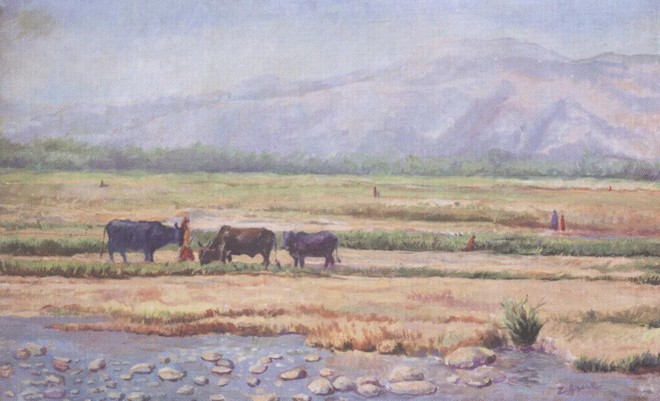

Salahuddin Mian, that apparently aloof professor of NCA, had a remarkable collection of anecdotes picked during his long years (made even longer by staying after college hours and working in the holidays including Eid) at the institute.
Occasionally, from his personal archive he would share from details about some important artists of this country. Once, he disclosed an encounter with three painters busy in their final year projects. He recalled the sense of competition among them; how all three were working secretively with each one trying to add more figures in his thesis painting.
One student seemed bitter and frustrated because his professor, an eminent artist, had suggested that he should focus on hunger and poverty from his background while the professor’s own work was about geometric abstract forms. A renowned painter now, this student was unable to grasp the essence of the learning process -- that a teacher must not influence but inspire. He must not produce his clones and followers but help shape individuals who do not imitate but use a diversity of knowledge to develop their own visual vocabulary and aesthetic choices.
This is the most challenging task for a teacher because the easiest course is to train students in one’s own art practice. This not only requires less work but also boosts the ego with so many young minds following the master’s example. One keeps seeing recent graduates producing works in the image of their tutors. But his happens only in their degree shows. Later, they grow out of it or the art world grows without them. This is a sad situation since some of them possess real talent but the dominance of a major artist wilts their artistic identity.
There are many moral questions and dilemmas in this for an artist who is also teaching at an art school. Sometimes, it is not through your teaching but your presence and success that you influence a number of artists you haven’t even met. Artists learn by emulating other artists’ works. Picasso’s earlier works indicate the presence of Paul Cezanne, Toulouse Lautrec, Georges Seurat among several others. Paul Cezanne, the great master of modern art, who influenced almost every artist after him, was trying to recreate Nicolas Poussin using nature as a reference.
Actually there is a slight but strong difference between the two terms ‘influence’ and ‘inspire’ which are often used interchangeably. Some artists can not come out of their powerful personalities while teaching. So the only way to learn from them is to accept their views on art, follow their practice and imitate their compositions, imagery and formal concerns. In art institutions, you may come across students or recent graduates who even speak in the same tone and manner as their mentors.
This may be encouraging and flattering for the artists who are leaving behind their loyal disciples. It is like giving birth to your own offspring with your features who would continue your lineage and make you immortal.
It is more difficult to have students who are seeking their own visual expressions with the help of their teachers. To accomplish this, an artist/teacher has to forgo his beliefs as a practitioner and be ready to accept divergent, often opposing, views on art.
Art incorporates multiple ways and views across times and cultures. If one takes the example of human representation the range of its rendering, from the Egyptian to Greek period, from the Mughal era to Hindu sculptures, from African societies to the courts of Japan and China, is so wide that no one scheme can be called absolute. With each shift in culture and change of time, humans started to see their bodies in new formats. Just like black & white pictures were considered real before the invention and popularity of colour photography.
Thus, a good art teacher is prepared to welcome all these varied practices which he may abhor as a painter. Being at an institution, he must broaden his choices and respect other points of view. Among such exemplary teachers, Khalid Iqbal is still remembered for his reluctance to influence students through his art. Yet, his words and works inspired a lot of artists from different generations. In fact, the difference between the two verbs, to influence and to inspire, is illustrated through Khalid Iqbal’s position as a teacher. He disliked and discouraged his students to follow him and hardly showed his own work to students.
But through a strange twist of fate and irony, Khalid Iqbal is the most copied painter today. A whole group of landscape painters are producing works which imitate the master on surface because these canvases lack the sensitivity and sophistication that makes and marks Iqbal a genius with the brush. It is his way of applying paint, capturing the atmosphere and building layers of colour, which distinguishes him from his followers.
In a recent exhibition (held from June 10-18 at the Ejaz Art Gallery, Lahore), five of his students’ works were displayed. These (the class of 1974 at NCA) included some well-known names such as Iqbal Hussain, Ghulam Mustafa and Bashir Ahmed along with Zulfiqar Ali Bhatti and Shireen Arif. Looking at their works, one realised how these were inspired from their teacher and forged different ways of representing reality. Whether it was graphite on paper by Bashir Ahmed, views of city by Ghulam Mustafa, quick brush strokes of Iqbal Hussain, landscapes painted by Zulfiqar Ali Bhatti or sensitive drawings of plants in colour pencils by Shireen Arif, it seems that each individual picked one element from the teacher and extended it.
It is hard to say if any of these were able to match the immaculate surfaces of Khalid Iqbal. This question may be addressed by these five former students because, no matter how long a person has been working, a new creative phase can start at any point in life.